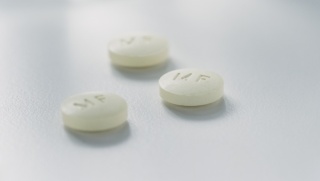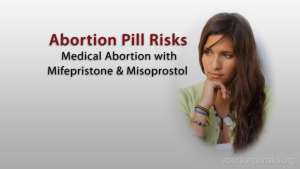The Abortion Pill
THE ABORTION PILL: OVERVIEW
|
Learn About The Abortion Pill. |
Information On This Page:
THE ABORTION PILL
What is the Abortion Pill (Mifepristone, RU- 486)?
The Abortion Pill, otherwise known as Mifepristone (U.S. trade name: Mifeprex) (1) or RU-486, is a medical or drug induced alternative to surgical or vacuum aspiration abortion for women who elect to terminate an early pregnancy. (2)
Two drugs are commonly used for medical abortion; the most effective regimen is the combination of Mifepristone and Misoprostol. (3)
The first drug, mifepristone, inhibits and blocks the essential reproductive hormone progesterone that plays a critical role for the initiation and maintenance of pregnancy. (4)
 |
Mifepristone blocks the hormone progesterone by interrupting pregnancy development and prompting the detachment of the implanted embryo. |
Mifepristone terminates pregnancy by initiating endometrial erosion that causes the developing placenta and embryo to detach from the lining of the uterus. (5)
The second drug, misoprostol, taken two days after the Mifepristone, causes dilation of the cervix and increases the frequency and strength of uterine contractions needed to expel the embryo and pregnancy tissue. (5)
| Misoprostol stimulates uterine contractions to expel the embryo and placental tissue. |  |
MIFEPRISTONE USE IN THE UNITED STATES
Mifepristone medical abortion is rapidly growing in the United States
Approximately 62% of all abortions occur in the first 9 weeks of pregnancy (from a woman’s last menstrual period). According to a 2008 report: (6)
- Medical abortion (mifepristone) accounted for 17 % of all non-hospital abortions
- Medical abortion accounted for 22% of all abortions before 9 weeks’ gestation
The number of early medical abortions and the proportion of all abortions accounted for by this method have grown substantially. Mifepristone use has grown steadily since its introduction in the United States in 2000, and substantially in recent years. (6)
Preliminary estimates indicate that mifepristone accounted for roughly 27% of eligible medical abortion abortions in 2009 in the United States and is continuing to grow as it promises to expand abortion services by going outside the domain of a typical abortion clinic. (7)
Mifepristone has increasingly become an integral part of abortion provision in the United States and likely has contributed to a trend toward very early abortions. (7)
INTERNATIONAL USE OF MIFEPRISTONE
What kind of international growth is mifepristone medical abortion experiencing?
Prior to discovery of the mifepristone for medical abortion, International agencies were looking for technologies and improved methods to stem global population growth in developing nations over concerns that population expansion would threaten the future availability of food, water, and other resources; thus threatening the well-being and survival of the human species. (5)
Mifepristone is approved and marketed in over 40 countries. (8) (9)
In 2005, mifepristone was included in the World Health Organization’s (WHO) Essential Medicines List. (9)
In recent years, several new mifepristone and prostaglandin analog (misoprostol) products have entered the international market increasing the availability and reducing the cost of both drugs. (9) (10)
In 2007, in Finland 64%, in Sweden 61%, and in the United Kingdom 35% of all abortions were performed using the medical method. The continuing increase in the number of medical abortions performed each year and the risk of major health complications is of great interest to patients and health care providers. (11)
WOMEN AT RISK
Can the increased use of mifepristone for medical abortion put women at greater risk?
Once a drug is marketed and used in thousands or even millions of individuals, it is more likely that rare adverse events or major complications can occur. (12)
Adverse events can range in severity from complications that are serious and life-threatening to those that can lead to hospitalization or death. (12)
The increased use of mifepristone/misoprostol for medical abortion may result in larger numbers of lethal infections from the clostridium sordellii bacterium. (13)
ABORTION PILL DEBATE
The Abortion Pill Debate and Controversy
Contrary to popular misconception, medical abortion with mifepristone and misoprostol to induce abortion is neither simple nor inexpensive. (14)
Medical abortion is associated with higher rates of prolonged bleeding, nausea, vomiting, and pain than is surgical abortion, and the rate of use of analgesic drugs is greater with medical abortion. (15)
Moreover, medical abortion has a lower rate of success than surgical abortion and requires more clinic visits than surgical abortion. (15)
There have been significant debates concerning the characterizations of medical abortion with respect to use of unapproved alternative regimen, the effectiveness of regimens, the accuracy of reported health risk data, and the systematic deficiencies of the FDA’s Adverse Event Reporting System. (14) (16)
The ability of mifepristone to induce medical abortion has generated considerable political, legal and religious controversy. (17)
ABORTION PILL NAMES
What are the different names for the Abortion Pill?
- Common Name: Abortion Pill
- Original Research Name: RU-38486 shortened to RU-486 (18)
- Generic Drug Name: Mifepristone (4)
- Commercial Trade Names: (19) (20) (21)
- Mifeprex (Mifepristone: United States)
- Mifegyne, MTPill, Mifegest, Mifeprin, Mifyron, Mefipil, Mifebort (Mifepristone: Other countries)
- Medabon (Mifepristone and misoprostol in a combined package: Other countries)
- Other Abortion Pill Names:
- Medical Abortion
- Medication Abortion
- Non-surgical or non-aspiration abortion
- Pharmacological Abortion
- The Early Option Pill
- MTP (Medical Termination of Pregnancy) pill
- “A” pill
- Antiglucocorticoid, Glucocorticoid Receptor Antagonist
- Antiprogesterone, Antiprogestin, Progesterone Agonist, Progesterone Antagonist, Progesterone Receptor Antagonists (PAs)
- Selective Progesterone Receptor Modulators (SPRMs)
1. Danco Laboratories, LLC. What is Mifeprex. Mifeprex (mifepristone tablets, 200 mg) the early option pill to end pregnancy. [Online] [Cited: June 15, 2011.] http://www.earlyoptionpill.com/section/what_is_mifeprex/.
2. Johnson, Judith. CRS Reports, Abortion Termination of Early Pregnancy with RU-486 (Mifepristone). University of Maryland School of Law, Thurgood Marshall Law Library, CRS Reports:Abortion. [Online] February 23, 2001. [Cited: September 3, 2010.] http://www.law.umaryland.edu/marshall/crsreports/crsdocuments/RL30866.pdf.
3. U.S.Department of Health & Human Services. Drugs@FDA, Label and Approval History, Mifepristone Labeling Revision. FDA, U.S. Food and Drug Administration. [Online] April 27, 2009. [Cited: July 16, 2011.] http://www.accessdata.fda.gov/drugsatfda_docs/label/2009/020687s015lbl.pdf.
4. Spitz IM, Bardin CW. Clinical pharmacology of RU 486 – an antiprogestin and antiglucocorticoid. Contraception, Vol. 48, Issue 5. November 1993, pp. 403-444.
5. Ulmann, Andre, Teutsch, Georges and Philibert, Daniel. RU 486. Abortionpillrisks.org. [Online] June 1990. [Cited: July 25, 2011.] https://abortionpillrisks.org/wp-content/uploads/2011/07/RU486_1990.06_Sci-Am_Ulmann_RU486.pdf.
6. Jones, Rachel K, et al., et al. Abortion in the United States: Incidence and Access to Services, 2005. Guttmacher Institute, Perspectives on Sexual and Reproductive Health. [Online] March 2008. [Cited: September 15, 2011.] http://www.guttmacher.org/pubs/journals/4000608.html. DOI:10.1363/4000608.
7. Jordan, Beth and Shields, Wayne C. Happy anniversary mifepristone: a decade of promise and challenges. Contraception Journal. September, 2010, Vol. 82, 3, Pages 219-220 .
8. Gynuity Health Projects. List of Mifepristone Approval. Gynuity Health Projects. [Online] June 24, 2010. [Cited: September 3, 2010.] http://gynuity.org/resources/info/list-of-mifepristone-approval/.
9. Abuabara, K; Blum, J; Bracken, H; Gynuity Health Projects. Providing Medical Abortion in Low-resource Settings: An Introductory Guidebook, 2nd Edition. Gynuity Health Projects. [Online] December 2009. [Cited: June 24, 2011.] http://gynuity.org/resources/info/medical-abortion-guidebook/.
10. Marie Stopes International. Medical abortion (the abortion pill), Abortion-Your Questions Answered booklet, Rev4. Marie Stopes International. [Online] January 2011. [Cited: September 20, 2011.] http://www.mariestopes.org.uk/Womens_services/Abortion/Abortion_options/Medical_abortion.aspx.
11. Niinimäki, Maarit, et al., et al. Immediate Complications After Medical Compared With Surgical Termination of Pregnancy, Obstetrics & Gynecology, 114(4):795-804. NCBI, PubMed. [Online] October 2009. [Cited: September 20, 2011.] http://www.ncbi.nlm.nih.gov/pubmed/19888037. PMID: 19888037.
12. PBS. Frontline, Dangerous Prescription,The FDA: Hazardous to Your Health?, Interview: Paul Seligman, M.D.,M.P.H. PBS.org, WGBH educational foundation. [Online] November 13, 2003. [Cited: August 16, 2011.] http://www.pbs.org/wgbh/pages/frontline/shows/prescription/interviews/seligman.html.
13. Ramirez, Norma and Abel-Santos, Ernesto. Requirements for Germination of Clostridium sordellii Spores In Vitro, p. 418-425, Vol. 192, No. 2. Journal of Bacteriology. [Online] January 2010. [Cited: September 13, 2011.] http://jb.asm.org/cgi/content/abstract/192/2/418. doi:10.1128/JB.01226-09.
14. Schaff, Eric A. Mifepristone: ten years later . Contraception, Volume 81, Issue 1 . October 2010, pp. 225-229.
15. Christin-Maitrem, S, Bouchard, P and Spitz, IM. Medical Termination of Pregnancy. The New England Journal of Medicine, 342:946-956. [Online] March 30, 2000. [Cited: July 25, 2011.] http://www.nejm.org/doi/full/10.1056/NEJM200003303421307.
16. Gary, Margaret M and Harrison, Donna J. Research Reports, Analysis of Severe Adverse Events Related to the Use of Mifepristone as an Abortifacient, Volume 40. The Annals of Pharmacotherapy. [Online] February 2006. [Cited: June 24, 2011.] http://www.theannals.com/cgi/content/abstract/aph.1G481v1.
17. Spitz, Irving. Mifepristone: where do we come from and where are we going? Clinical development over a quarter of a century. Contraception, vol. 82, issue 5. November 2010, pp. 442-452.
18. Merriam Webster . RU-486. Merriam-Webster Online Dictionary and Thesaurus. [Online] 2011. [Cited: January 13, 2011.] http://www.merriam-webster.com/dictionary/ru-486.
19. U.S. Department of Health & Human Services. Drugs, Mifeprex (mifepristone) Information. FDA, U.S. Food and Drug Administration. [Online] July 19, 2011. [Cited: July 19, 2011.] http://www.fda.gov/drugs/drugsafety/postmarketdrugsafetyinformationforpatientsandproviders/ucm111323.htm.
20. IPAS India. Refresher course for medical abortion services, Reference manual, REFMA-IND-E09. IPAS. [Online] March 15, 2009. [Cited: January 17, 2011.] http://www.ipas.org/en/Resources/Ipas%20Publications/Refresher-course-for-medical-abortion-services-Reference-manual.aspx
21. Concept Foundation. Home: Medabon for Medical Abortion. Medabon. [Online] August 17, 2009. [Cited: January 17, 2011.] http://www.medabon.info/.
Page Last Updated: 07/25/2012



Comments on this entry are closed.